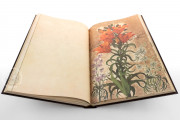The Album of Botanical Paintings by Franciscus de Geest, a famous seventeenth-century Baroque painter from Holland (1638-1699), is a fascinating anthology of plants.
From portraits to plants: the journey of a great painter
De Geest, who had become famous for painting portraits and still-lifes, also enthusiastically devoted himself to the illustration of flowers, which resulted in this splendid manuscript anthology of plants, dated "Leeuwarden 1668" and currently held in the Biblioteca Nazionale in Rome.
It is a collection of 201 original drawings made directly from the plants and splendidly coloured using a combination of techniques. It provides evidence of the variety of flowered plants cultivated in botanical gardens at that time and of the extensive collections of the highly sought-after tulips originating in the Orient. A testimony to the immense variety of species that were cultivated in Europe.
Duilio Contin (commentary author) wrote: "The Hortus amoenissimus by Franciscus de Geest is an extraordinary collection of 198 works of art, so many plates, drawn with a precise phytographic and watercolour technique with an elegant taste for a mise en page of 17th century art. A jubilant celebration of colour and mild accompanying flavours such as rose, hemerocallis, lilium, mallow and especially a multitude of tulips so alive that they seem to be just cut, in a grand, multi-coloured and joyful baroque garden. Franciscus de Geest fully seizes the botanic spirit and interest of his time and his works are worthy of a place among the best floral painters of that time".
We have 1 facsimile edition of the manuscript "Album of Botanical Paintings": Hortus amoenissimus... di Franciscus de Geest facsimile edition, published by Aboca Museum, 2011
Request Info / Price
























